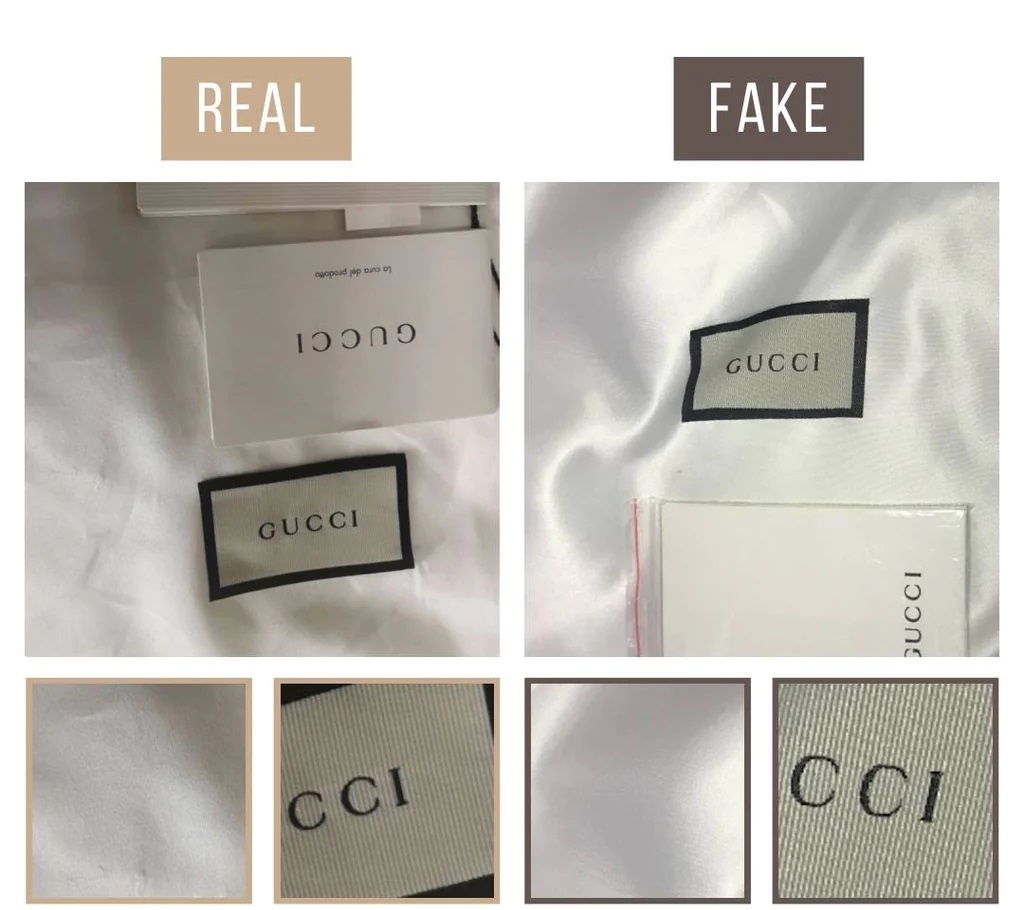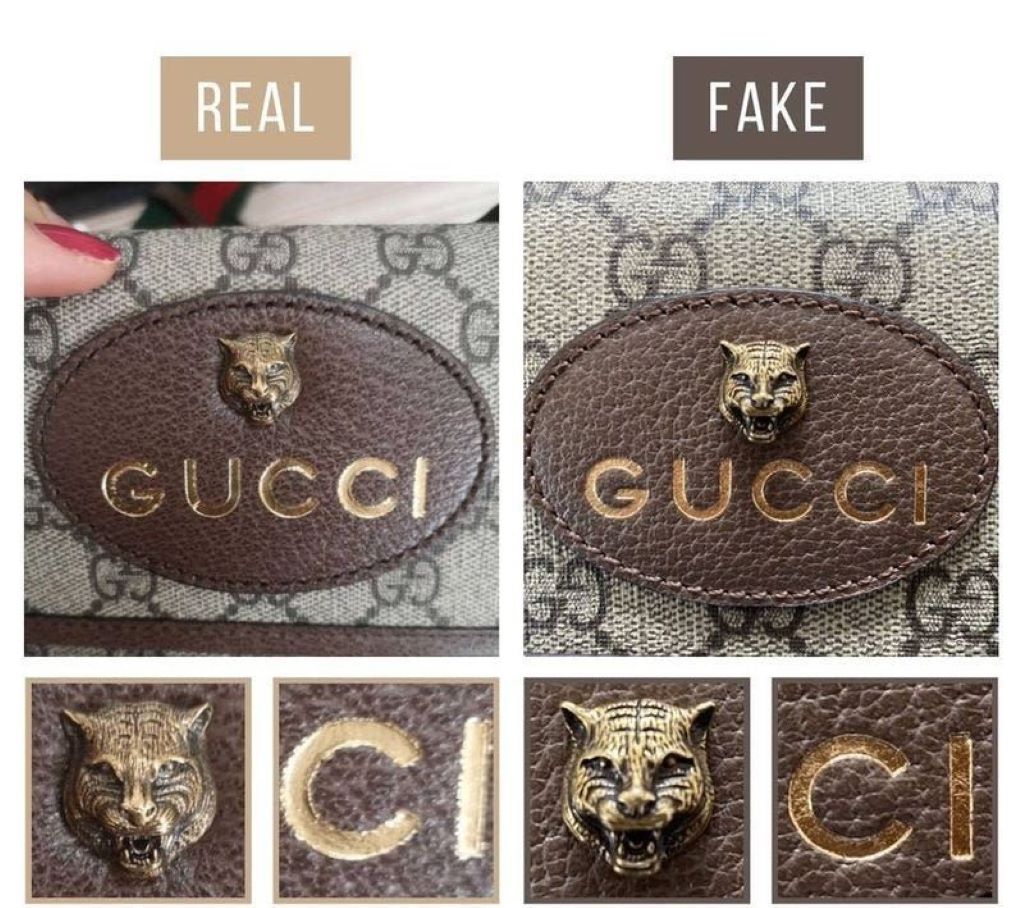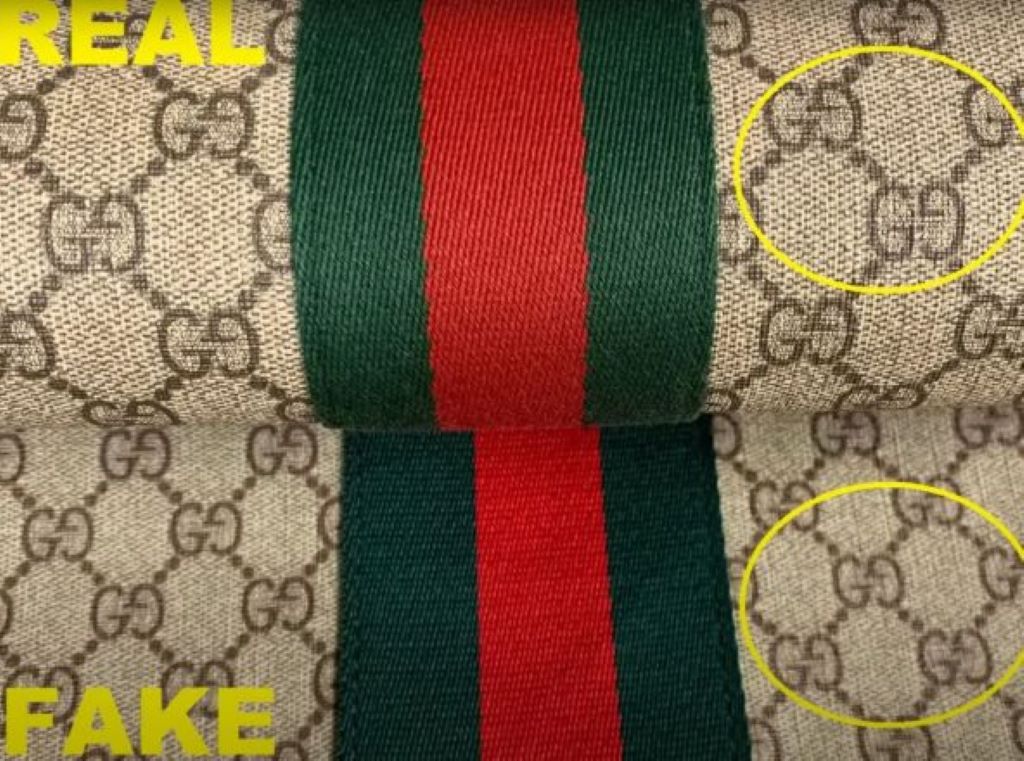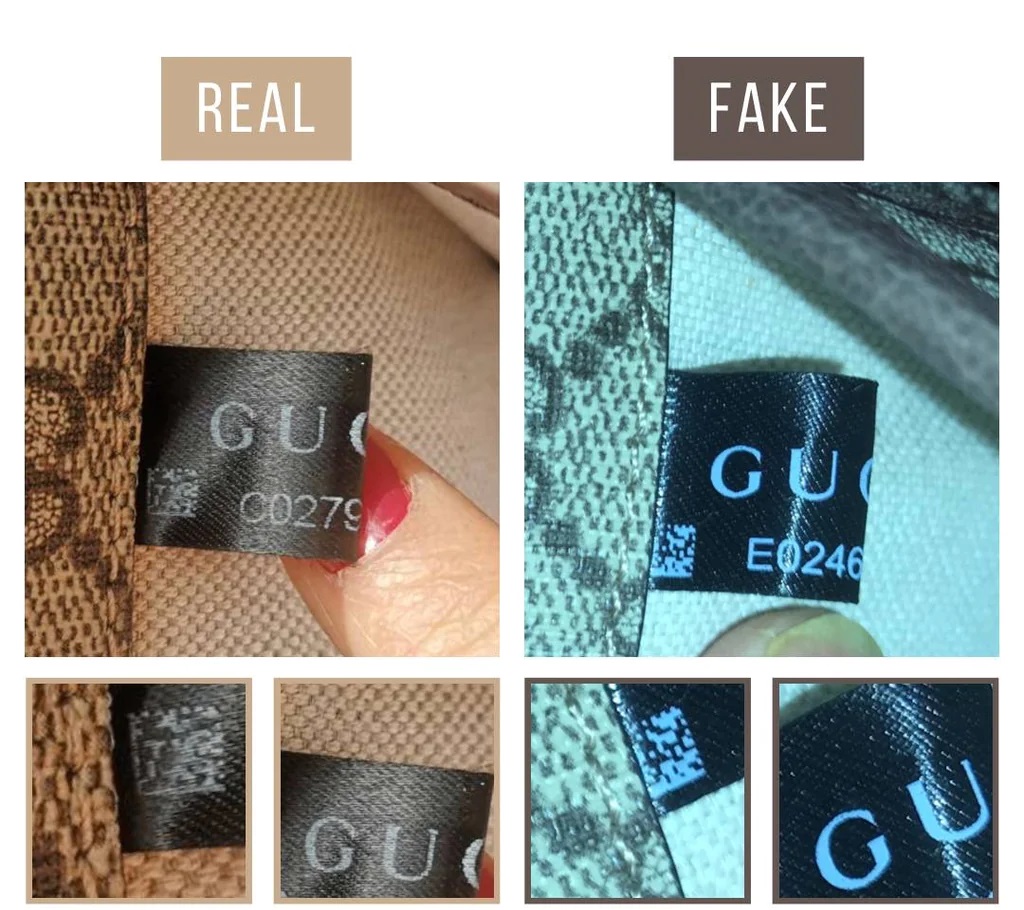
Gucci stands out as one of the most coveted and counterfeited luxury brands globally, making the authentication of a genuine Gucci bag quite challenging. With a flood of fake Gucci bags in the market, it’s essential to be vigilant. There are several telltale signs to look for when determining the authenticity of a Gucci bag. Additionally, if you own a Gucci bag and are curious about the brand’s repair policy, it’s advisable to inquire about their Gucci bag repair policy directly with the official channels or authorized retailers.
1. Inspect the Gucci Logo
One of the easiest ways to spot a fake Gucci bag is to examine the Gucci logo carefully. An authentic Gucci logo should have clean lines, precise spacing, and excellent quality.
Here’s what to look for when inspecting the logo:
- Font: The font used for the Gucci logo is very specific. It should be a bold serif font with tight kerning. Letters like the “G” and “C” have a unique shape.
- Spacing: The spacing between letters should be consistent. No letters should touch each other.
- Quality: On real Gucci bags, the logo will be deeply and cleanly embossed or engraved into the leather. Fake logos often sit more superficially on the surface.
- Color: Depending on the bag, the logo may be a gold or silver tone. But it should not look faded or rub off.
- Location: Logo placement varies by Gucci bag style. But on most, it is usually centered on the front or along a leather tab.
If the Gucci logo looks poorly constructed, uneven, cheap, or flimsy, then the bag is likely not authentic.
2. Check the Serial Number
All Gucci bags come with a unique serial number embossed inside the bag. This is one of the most reliable ways to authenticate its origins.
When checking the serial number:
- It should be clear and deep without any smudging. Fake serial numbers are often faint or blurred.
- The numbering system should make logical sense. Authentic Gucci numbers have 12 digits with no letters or special characters.
- The first one or two numbers denote the bag style. The next set of numbers is the ID code. No two Gucci bag ID codes should be identical if both are real.
- Run the serial number through Gucci’s authenticity check online. If a fake serial number is entered, the website will let you know it’s inauthentic.
- Call Gucci’s customer service line and read the serial number out loud. They can confirm if the number belongs to a real Gucci creation.
If the serial number is obviously forged, misplaced, or inaccurate, then alarm bells should be ringing about the bag’s legitimacy.
3. Inspect the Stitching
Gucci bags boast incredibly high-quality stitching and meticulous construction. Inspect every inch of stitching to make sure it meets Gucci’s craftsmanship standards.
Here’s what to look for:
- Straight stitches: Check that every stitch runs in a perfectly straight line. There should be no crooked or wobbly stitches.
- Small stitches: Gucci stitching should be tightly placed with tiny stitch intervals. Larger, looser stitches indicate a counterfeit.
- Clean finish: On the inside and outside, stitches should have neat, secure edges. There should be no loose threads or fraying.
- Color match: The thread color should match or blend nicely with the leather. Bright white stitching is often a red flag.
- Hand-stitched: Some Gucci bags feature visible hand-stitching inside the bag. It will have an imperfect, bumpy texture vs. machine-stitched seam.
- Hidden stitches: For coated canvas bags, stitches should be hidden neatly between the leather trim and the canvas. Shoddy stitch placement is a dead giveaway.
If the stitching varies in size, texture, or color, then the quality craftsmanship simply isn’t there.
4. Analyze the Hardware
The hardware details of a Gucci bag, from zippers to snaps to buckles, speak volumes about the bag’s authenticity when inspected thoroughly.
Here are some best practices for evaluating the hardware:
- Metal quality: Hardware should feel nicely weighted, not lightweight. Gucci only uses metals like solid brass for zippers.
- Engravings: Any engravings into hardware pieces should be clear and precise without inconsistencies.
- Finish: Hardware finishes should not be tarnished, faded, or rubbing off. The coating should be evenly applied.
- Logos: Any Gucci logos on hardware should be correctly sized and placed. Their font and spacing should align with real Gucci designs.
- Attachment: Hardware should sit seamlessly against the bag without gaps, overlaps, or protruding edges.
- Functionality: Zippers should glide smoothly. Snaps should click crisply into place without resistance.
- Interior label: Inside the bag should sit a metal label with “Gucci” and often “Made in Italy.” It should not look cheaply stamped.
While high-quality hardware can bump up manufacturing costs, Gucci never compromises on using the real deal.
5. Smell the Leather’s Aroma
A telltale sign of an authentic leather luxury bag versus a fake is the smell. When you press your nose against the leather of a real Gucci bag, you should detect the natural scent of true leather.
Here’s what to look out for when taking a whiff:
- Strong leather smell: Authentic leather gives off a strong, potent odor. Faux leather has no or very faint smell.
- Earthy aromas: Notes of wood, hides, tobacco, or grass indicate genuine leather derived naturally from animal hide.
- Lack of chemicals: Real leather shouldn’t emit fumes of adhesives, paints, or plastics. Fakes often reek of chemicals.
- Consistent scent: The leather smell should permeate throughout the entire bag, not just certain patches.
Trust your senses. If the bag fails to produce that coveted leather aroma, then it simply may not be the real deal. The smell test doesn’t lie.
6. Touch the Bag’s Materials
The feel and texture of the bag’s leather, canvas, suede, or exotic skins can provide many hints into its validity when touched.
Here’s a texture checklist when handling the materials:
- Buttery leather: High-grade leather has an ultra-smooth finish yet retains a subtle grainy feel. Faux leather feels more plastic-y.
- Canvas flexibility: Authentic Gucci canvas contains a linen-cotton blend, so it should bend easily without creasing. Rigid canvas indicates a cheaper composition.
- Suede naps: Brush your fingers against the suede’s nap, which should feel thick and plush. Fake suede feels rough or bald.
- Exotic embossed skins: Alligator and snakeskin should retain a bumpy embossing. Fakes often look overly smooth or irregular.
- Tarnish-resistance: Real metals like solid brass don’t rub off on your hands over time. Low-grade alloys used on fakes tend to tarnish and fade.
There’s truly no substitute for the buttery softness of a real Gucci leather bag under your fingertips.
7. Search for the “Made in Italy” Stamp
All authentic Gucci bags will contain the stamped words “Made in Italy” somewhere on the interior or exterior of the bag. This stamp guarantees its construction in Gucci’s Italian workshops.
Here are some tips for spotting the marker:
- Interior leather tab: Inside many bags, the stamp sits on a leather tab sewn into the lining. Make sure the ink is clearly legible.
- Underside of zipper: On small leather goods like wallets, the stamp appears on the bottom of an interior zipper.
- Back exterior: On certain bag styles, the marker is printed on the backside lower corner.
- Front plaque: Some bags feature an external leather plaque with the iconic Gucci script and “Made in Italy.”
- Bottom exterior: The stamp might be subtly embossed on the exterior bag bottom in a contrasting foil or ink.
- Absent stamp: If the bag lacks the “Made in Italy” markers anywhere, it’s a huge red flag that it’s inauthentic.
For staunch proof of Italian craftsmanship, the “Made in Italy” detail is the ultimate stamp of approval.
8. Match It Against an Authentic Bag
If you’re still uncertain about a bag’s authenticity, the best method is to compare it side-by-side to a version known to be real.
Here’s how to conduct the match-up:
- Online images: Study images of the specific Gucci bag by searching its name and model number. Note key traits like stitch placement, leather finish, logo details etc.
- In the boutique: Bring the bag into an official Gucci boutique. Have a sales associate do a direct comparison to a bag on their floor.
- Your own collection: If you already own an authentic Gucci bag in the same style, meticulously compare each element – from leather grain, to color hue, to the weigh of the hardware.
- Seller photos: Ask the seller to provide photos of the exact bag from multiple angles. Cross-reference markings, dimensions, hardware and other specifics against photos of the real thing.
- Videos: Study YouTube unboxing videos of the particular bag model, zooming in on all the nuances that distinguish it as a bonafide Gucci.
Having an original side-by-side reveals even the most minor of discrepancies that the naked eye may otherwise miss. There’s no better test than to literally match up an authentic Gucci against the one in question.
9. Confirm Country of Origin
Check where the Gucci bag supposedly originates from based on the seller or paperwork. All authentic Gucci bags are designed and produced exclusively in Italy.
Here are the facts around Gucci origins:
- Made in Italy: Gucci bags are only crafted within Gucci’s Italian workshops in Florence, Milan, and Scandic. “Made in Italy” should always be embossed.
- No outsourcing: Gucci never licenses production out to other countries, unlike some brands. So “Made in China” is an instant red flag.
- Italian materials: Gucci sources its signature leather and fabrics from Italian tanneries to uphold quality.
- No COO exception: Gucci bags lacking a “Made in Italy” stamp are always counterfeit without exception. There are no special production circumstances.
- Legacy: Gucci has been operating out of Italy since 1921. No authentic Guccis are crafted outside of Italy, period.
The sole and exclusive country of origin for all genuine Gucci handbags, wallets and accessories is Italy. Anything made elsewhere is fraudulent.
10. Analyze the Dust Bag and Packaging
An authentic Gucci bag will come nestled inside a high-quality dust bag and ornate packaging. Replicas often skimp on getting the bag details right.
When inspecting the dust bag and box:
- Fabric quality: Dust bags feel silky and durable. Fakes use thin, rough fabrics that seem cheap.
- Drawstring: The bag’s drawstring should be made of a thick satin material. Fake cords are flimsy and frayed.
- Logo: The front of the dust bag features a tonal interlocking GG Gucci logo. It should be clear and properly proportioned.
- Box print: Any text or graphics on the box should be cleanly printed without bleeding, smudging or pixelation.
- Paper quality: Gift boxes and tissue paper should feel rigid and nicely weighted, not flimsy.
- Texture: Guccissima bags come with dust bags featuring the logo woven into the fabric for texture.
- Size: Dust bag dimensions should properly fit the corresponding bag model. Oversized or undersized bags indicate a fake.
While dust bags and boxes seem minor, Gucci obsesses over details. Fakes simply fail to mimic such meticulous quality touch points.
Spotting Fake Gucci Bags on Resale Sites
Major reseller platforms like eBay, Poshmark and The RealReal are teeming with convincing Gucci counterfeits. Here are some ways to detect fake Gucci bags when shopping secondhand sites:
- Low price: Authentic vintage Gucci bags still hold value and rarely dip below $300 even in used condition. New Gucci bags run $1,500+. Anything substantially cheaper raises doubts.
- Stock images: Most counterfeit sellers don’t have the actual bag on hand. So they use stock images which may look pristine and nothing like the bag’s condition described. Ask for photos of the exact bag.
- Missing accessories: Genuine vintage Guccis come with dust bags and often authentication cards. If these accessories are missing, it may be a replica.
- Seller feedback: Check what percentage of positive feedback a seller has earned. Consistently negative reviews signal possible inauthentic goods.
- Location: Gucci knockoffs overwhelmingly originate overseas in China, Hong Kong, Turkey and other foreign countries. Be wary of international sellers.
With the rise of “super fakes”, extra scrutiny is required when Gucci shopping online. But following these tips will help spot the phonies.
5 Gucci Authentication Tips
- Use Gucci’s online authenticity checker with a serial number, receipt, or product code.
- Bring the bag to the Gucci store. Store associates can analyze small details.
- Contact a professional authenticator to get a qualified second opinion.
- Search the style name and number to confirm it’s a real Gucci model.
- Study reference photos of that exact Gucci model to note distinct characteristics.
Gucci Bag Authentication Services
For definitive authentication, consider hiring a professional Gucci inspector:
- Real Authentication: Specializes in luxury goods. Offers certificates of authenticity.
- Entrupy: Uses advanced technology like AI imaging and lab scans. Fast digital results.
- Authenticate First: Worldwide experts conduct thorough manual examinations. Reasonably priced online.
- Legit Grails: Popular YouTubers detail flaws in luxury fakes. Also sell “mystery boxes.”
When in doubt, leave it to the professionals. Their expertise provides peace of mind.
Maintain Your Investment with Genuine Gucci
So there you have it – the top ten tips for verifying genuine Gucci bags to safeguard your investment. While scoring a great deal may be tempting, nothing compares to the craftsmanship and enduring style of the real thing. By arming yourself with this authentication knowledge, you can confidently spot the fakes and remain a happy member of the Gucci club. When in doubt, go directly to the source – within Gucci’s website, boutiques and craftsmen lies all the answers to authenticate your next statement-making Gucci treasure.
Conclusion
- Authenticating Gucci requires a multi-point inspection of the logo, stitching, serial number, hardware, materials, detailing, craftsmanship and packaging.
- Study the distinct specifications of each Gucci bag model using online guides and boutique references.
- Genuine Gucci bags are exclusively “Made in Italy” and constructed from fine Italian materials.
- Ensure the longevity of your leather Coach purse by learning how to clean it effectively. Need authentication? Consult Gucci’s official website and customer service for support, or opt for certainty with a professional inspector.
- While tempting deals exist, purchasing resale Gucci from reliable sellers helps avoid buying convincing fakes.
- When armed with the facts, Gucci lovers can confidently invest in the real deal for a lifetime of enjoyment.
FAQs
Q: What should an authentic Gucci serial number look like?
A: Authentic Gucci serial numbers contain 12 digits like 204305709382. The first 1-2 digits denote the style. The next set of numbers forms a unique ID code.
Q: Do all real vintage Gucci bags say “Made in Italy” inside?
A: Yes, even vintage Gucci bags from the 1960s-1990s contain the “Made in Italy” stamp. Gucci has always produced bags exclusively in Italy.
Q: Where can I get a Gucci bag authenticated?
A: You can take it to the Gucci store, contact an online authentication service, or use Gucci’s real vs fake checking tool on their website.
Q: What are signs of a fake Gucci purse?
A: Signs include misshapen logos, cheap materials, uneven stitching, flimsy hardware, lack of serial number, and absence of the “Made in Italy” stamp.
Q: Do authenticators damage bags?
A: Reputable authenticators should not damage your bag during inspection. Minor pen marks may occur on the interior. Avoid any service that requires disassembling bags.



